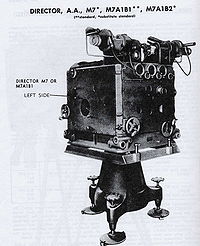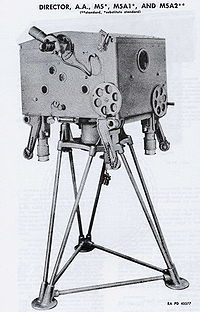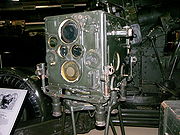.gif)
Director (military)
Encyclopedia

A director, also called an auxiliary predictor, is a mechanical
Machine
A machine manages power to accomplish a task, examples include, a mechanical system, a computing system, an electronic system, and a molecular machine. In common usage, the meaning is that of a device having parts that perform or assist in performing any type of work...
or electronic
Electronics
Electronics is the branch of science, engineering and technology that deals with electrical circuits involving active electrical components such as vacuum tubes, transistors, diodes and integrated circuits, and associated passive interconnection technologies...
computer that continuously calculates trigonometric
Trigonometry
Trigonometry is a branch of mathematics that studies triangles and the relationships between their sides and the angles between these sides. Trigonometry defines the trigonometric functions, which describe those relationships and have applicability to cyclical phenomena, such as waves...
firing solutions for use against a moving target, and transmits targeting data to direct the weapon firing crew.
For warships
For warships of the 20th century, the director is part of the fire control system; it passes information to the computer that calculates range and elevation for the guns. Typically, positions on the ship measured range and bearing of the target; these instantaneous measurements are used to calculate rate of change values, and the computer ("fire control table" in Royal NavyRoyal Navy
The Royal Navy is the naval warfare service branch of the British Armed Forces. Founded in the 16th century, it is the oldest service branch and is known as the Senior Service...
terms) then predicts the correct firing solution, taking into account other parameters, such as wind direction, air temperature, and ballistic factors for the guns.
On ships the director control towers for the main battery are placed high on the superstructure, where they have the best view.
Anti-aircraft
For anti-aircraft use, directors are usually used in conjunction with other fire control equipment, such as height finderHeight finder
A height finder is a ground based aircraft altitude measuring device.Early height finder implementations were optical devices and later migrated to radar devices. Devices combining both optics and radar were deployed by the U.S...
s or fire control radars.
Example

Bofors 40 mm gun
The Bofors 40 mm gun is an anti-aircraft autocannon designed by the Swedish defence firm of Bofors Defence...
(called a fire unit) used in its anti-aircraft role has the M5 director for its fire-control system
Fire-control system
A fire-control system is a number of components working together, usually a gun data computer, a director, and radar, which is designed to assist a weapon system in hitting its target. It performs the same task as a human gunner firing a weapon, but attempts to do so faster and more...
. The director is operated by a member of the range section who reports to the chief of section, who in turn reports to the platoon
Platoon
A platoon is a military unit typically composed of two to four sections or squads and containing 16 to 50 soldiers. Platoons are organized into a company, which typically consists of three, four or five platoons. A platoon is typically the smallest military unit led by a commissioned officer—the...
commander. The range section's leader is also called a range setter; he guides the preparation of the director and generator for firing, verifies the orientation and synchronisation of the gun and the director, and supervises fire control using the M5 director (or by the carriage when the M7 Weissight is used). The range section that uses the M5 director consists of the range setter, elevation tracker, azimuth tracker, power plant operator and telephone operator.
The M5 director is used to determine or estimate the altitude
Altitude
Altitude or height is defined based on the context in which it is used . As a general definition, altitude is a distance measurement, usually in the vertical or "up" direction, between a reference datum and a point or object. The reference datum also often varies according to the context...
or slant range
Slant range
In radio electronics especially radar terminology, slant range is the line-of-sight distance between two points which are not at the same level relative to a specific datum....
of the aerial target. Two observers then track the aircraft through a pair of telescope
Telescope
A telescope is an instrument that aids in the observation of remote objects by collecting electromagnetic radiation . The first known practical telescopes were invented in the Netherlands at the beginning of the 1600s , using glass lenses...
s on opposite sides of the director. The trackers turn handwheels to keep the crosshairs of their respective telescope on the aircraft image. The rotation of the handwheels provides the director with data on the aircraft's change in elevation and change in azimuth in relation to the director. As the mechanisms inside the director respond to the rotation of the handwheels, a firing solution is mechanically calculated
Mechanical calculator
A mechanical calculator is a device used to perform the basic operations of arithmetic. Mechanical calculators are comparable in size to small desktop computers and have been rendered obsolete by the advent of the electronic calculator....
and continuously updated for as long as the target is tracked. Essentially, the director predicts future position based on the aircraft's present location and how it is moving.
After their introduction, directors soon incorporated correction factors that could compensate for ballistic
Ballistics
Ballistics is the science of mechanics that deals with the flight, behavior, and effects of projectiles, especially bullets, gravity bombs, rockets, or the like; the science or art of designing and accelerating projectiles so as to achieve a desired performance.A ballistic body is a body which is...
conditions such as air density, wind velocity and wind direction
Wind direction
Wind direction is reported by the direction from which it originates. For example, a northerly wind blows from the north to the south. Wind direction is usually reported in cardinal directions or in azimuth degrees...
. If the director was not located near the gun sections, a correction for parallax error could also be entered to produce even more accurate firing direction calculations.
Directors transmit three important calculated firing solutions to the anti-aircraft gun firing crew: the correct firing azimuth and quadrant elevation calculated to determine where exactly to aim the gun, and for guns that use ammunition
Ammunition
Ammunition is a generic term derived from the French language la munition which embraced all material used for war , but which in time came to refer specifically to gunpowder and artillery. The collective term for all types of ammunition is munitions...
with timed fuzes
Fuze
Fuze Beverage, commercially referred to as just Fuze , is a manufacturer of teas and non-carbonated fruit drinks enriched with vitamins. Currently the brand consists of five vitamin-infused lines: Slenderize, Refresh, Tea, Defensify, and Vitalize...
, the director also provides the flight time for the projectile so the fuze can be set to detonate in close proximity
Fragmentation (weaponry)
Fragmentation is the process by which the casing of an artillery shell, bomb, grenade, etc. is shattered by the detonating high explosive filling. The correct technical terminology for these casing pieces is fragments , although shards or splinters can be used for non-preformed fragments...
to the target.
Early anti-aircraft artillery batteries
Artillery battery
In military organizations, an artillery battery is a unit of guns, mortars, rockets or missiles so grouped in order to facilitate better battlefield communication and command and control, as well as to provide dispersion for its constituent gunnery crews and their systems...
located the directors in the middle of the position, with the firing sections (guns) located at the corners of the position. Before the introduction of radar
Radar
Radar is an object-detection system which uses radio waves to determine the range, altitude, direction, or speed of objects. It can be used to detect aircraft, ships, spacecraft, guided missiles, motor vehicles, weather formations, and terrain. The radar dish or antenna transmits pulses of radio...
s, searchlight
Searchlight
A searchlight is an apparatus that combines a bright light source with some form of curved reflector or other optics to project a powerful beam of light of approximately parallel rays in a particular direction, usually constructed so that it can be swiveled about.-Military use:The Royal Navy used...
s were used in conjunction with directors to allow night target engagement.
U.S. Army directors

- T1 (wilson) director
- T4 gun director used with 3-inch M1918 gun3-inch M1918 gunThe 3-inch M1918 gun was a United States 3-inch anti-aircraft gun that entered service in 1918 and served until it was finally superseded by the 90 mm M3 gun just prior to the opening of World War II...
- T6 was built by Sperry CorporationSperry CorporationSperry Corporation was a major American equipment and electronics company whose existence spanned more than seven decades of the twentieth century...
in 1930 and standardized as the M2 director. - M3 was standardized from the T8 in 1934
- M4 was standardized in 1939
- M5 Gun Director Mechanical, a US-produced Kerrison PredictorKerrison PredictorThe Kerrison Predictor was one of the first fully automated anti-aircraft fire-control systems. The predictor could aim a gun at an aircraft based on simple inputs like the observed speed and the angle to the target...
, for use with 37mm Gun M137mm Gun M1The 37mm Gun M1 was an anti-aircraft autocannon developed in the United States. It was used by the US Army in World War II.In addition to the towed variant, the gun was mounted, with two M2 machine guns, on the M2/M3 half-track, resulting in the T28/T28E1/M15/M15A1 series of multiple gun motor...
and M1 40 MM- M5A1
- M5A2
- M7 gun director was standardized in 1941, and is similar to the M4 but added power control to the guns it is still described as a mechanical system. for use with 90 mm gun90 mm gunThe American 90 mm family of guns served as primary heavy anti-aircraft and anti-tank guns, playing a role similar to the renowned German 88 mm gun. They were the US's primary anti-aircraft guns from just prior to the opening of World War II into the 1950s when most AAA was replaced by missile...
- M7A1B1
- M7A1B2
- T10 standardized as M9 gun director electrical for use with 90 mm gun90 mm gunThe American 90 mm family of guns served as primary heavy anti-aircraft and anti-tank guns, playing a role similar to the renowned German 88 mm gun. They were the US's primary anti-aircraft guns from just prior to the opening of World War II into the 1950s when most AAA was replaced by missile...
produced by Bell LabsBell LabsBell Laboratories is the research and development subsidiary of the French-owned Alcatel-Lucent and previously of the American Telephone & Telegraph Company , half-owned through its Western Electric manufacturing subsidiary.Bell Laboratories operates its...
- M9B1
- M10 gun director electrical for use with 120 mm M1 gun120 mm M1 gunThe 120 mm Gun M1 was the United States Army's standard super-heavy anti-aircraft gun, complementing the smaller and more mobile 90 mm M3 in service. Its maximum altitude was about , which garnered it the nickname the stratosphere gun. The 120 served primarily in U.S. defensive roles, although...
Naval directors
- Mark 1
- MK 51 Fire Control System
- Mark 57
- Mark 58
- Mark 59
- Type 6 director (PRC)
Surviving examples

- South African National Museum of Military HistorySouth African National Museum of Military HistoryThe South African National War Museum in Johannesburg was officially opened by Prime Minister Jan Smuts on 29 August 1947 to preserve the history of South Africa's involvement in the Second World War. In 1975 the museum was renamed the South African National Museum of Military History and its...
- Number 1 Mark II Predictor - Powerhouse MuseumPowerhouse MuseumThe Powerhouse Museum is the major branch of the Museum of Applied Arts and Sciences in Sydney, the other being the historic Sydney Observatory...
- Vickers No.1 anti-aircraft predictor, 1942
See also
- Ship gun fire-control systems
- RangekeeperRangekeeperRangekeepers were electromechanical fire control computers used primarily during the early part of the 20th century. They were sophisticated analog computers whose development reached its zenith following World War II, specifically the Computer Mk 47 in the Mk 68 Gun Fire Control system. During...
- Gun data computerGun Data ComputerThe gun data computer is a series of artillery computers used by the U.S. Army, for coastal artillery, field artillery, and antiaircraft artillery applications...
- Fire-control systemFire-control systemA fire-control system is a number of components working together, usually a gun data computer, a director, and radar, which is designed to assist a weapon system in hitting its target. It performs the same task as a human gunner firing a weapon, but attempts to do so faster and more...
- Kerrison PredictorKerrison PredictorThe Kerrison Predictor was one of the first fully automated anti-aircraft fire-control systems. The predictor could aim a gun at an aircraft based on simple inputs like the observed speed and the angle to the target...
- Hendrik Wade BodeHendrik Wade BodeHendrik Wade Bode , was an American engineer, researcher, inventor, author and scientist], of Dutch ancestry. As a pioneer of modern control theory and electronic telecommunications he revolutionized both the content and methodology of his chosen fields of research.He made important contributions...
- John Whitney (animator)John Whitney (animator)John Whitney, Sr. was an American animator, composer and inventor, widely considered to be one of the fathers of computer animation.-Life:...
External links
- Mark 51 Gun director
- Director Firing Handbook index from HMS Dreadnought project
- Gunnery Pocket book HNSA.org
- http://web.mit.edu/STS.035/www/PDFs/sperry.pdf
- http://books.google.com/books?id=sExvSbe9MSsC&printsec=frontcover&dq=Between+Human+and+Machine
- http://books.google.com/books?id=T-IDAAAAMBAJ&pg=PA801&dq=m16+gun+data+computer&as_brr=1

